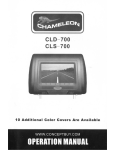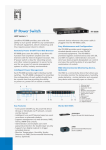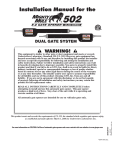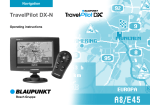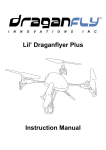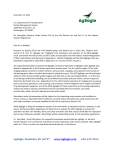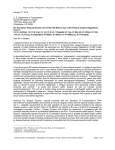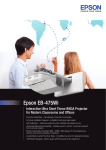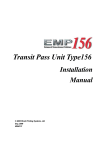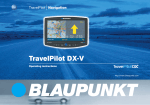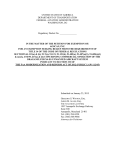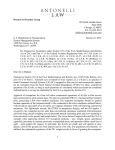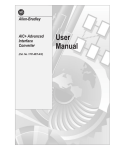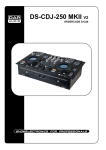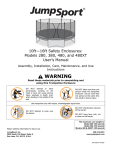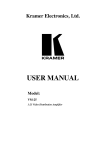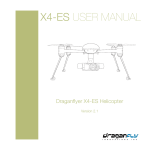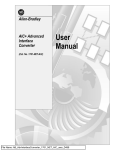Download Draganfly_Innovations_Inc_ - Drone Laws Blog by Antonelli Law
Transcript
October 22, 2014
,f±· •..
U.S. Department of Transportation
Docket Management System
1200 New Jersey Ave., SE
Washington, DC 20590
;
·..
".../
Re: Exemption Request Under Section 333 of the FAA Reform Act and Part 11 of the Federal
Aviation Regulations
Dear Sir or Madam:
Pursuant to Section 333 of the FAA Modernization and Reform Act of 2012 (the "Reform Act")
and 14 C.F.R. Part 11, Draganfly Innovations Inc. ("Draganfly"), the developer and operator of
the Draganflyer X4P, Draganflyer X4ES, Draganflyer X6 and Draganflyer Guardian
(collectively, Draganflyer Systems) small Unmanned UAS Systems ("sUAS") seeks an
exemption from the Federal Aviation Regulations ("FARs") listed below and discussed in
Appendix A. Details of Draganfly and the Draganflyer X4P, Draganflyer X4ES, Draganflyer X6
and Draganflyer Guardian sUAS are described in Appendix B. Attached as Appendix C is a
summary of this request.
The requested exemption would permit Draganfly commercial operation of Draganfly's
Draganflyer X4P, Draganflyer X4ES, Draganflyer X6 and Draganflyer Guardian( see details in
Appendix B), each which weigh less 5.5 lbs with imaging payloads, to perform market research,
aerial surveys, mapping, and inspections that consist of still photographs, video, and other data
taken by on board sensors. The Draganflyer Systems produce high quality imagery and data that
can be used independently or in the case of surveying and modelling, can be combined to
produce precision digital point clouds, triangle models, and contour maps of the surveyed area.
Applications for these sUASs include assistance to law enforcement agencies for criminal
investigation, traffic accident reconstruction and tactical support, emergency services
emergency site management in cases of natural and manmade disasters as well as search and
rescue, environmental monitoring, wildlife monitoring and enforcement, in inspection of
sensitive infrastructure including oil and gas pipelines, flare stacks, power lines,
communications towers, wind turbines, and surveying tasks such as precision agriculture,
mining, transportation, and forestry. Use of Draganflyer Systems for these emergency services,
inspection and surveying applications reduces the need to operate conventional aircraft,
providing data more safely, quickly, accurately, economically, and with reduced environmental
impact.
Operations under the exemption will be subject to strict operating requirements and conditions
to ensure at least an equivalent level of safety to currently authorized operations using manned
UAS and under conditions as may be modified by the FAA as required by Section 333.
Draganfly anticipates that while it is filing this exemption request on its own behalf, its
customers, in the future, will file exemption applications to allow them to operate the Draganflyer
X4P, Draganflyer X4ES, Draganflyer X6 and Draganflyer Guardian in commercial operations at
their own locations, that require aerial data for law enforcement and emergency services or to
support, inspections and surveys. Wherever possible, those filings will be substantially similar to
this exemption application.
Page 1 of 22
As described more fully below, the requested exemption would authorize Draganfly to perform
market research and commercial operations of aerial inspections and surveys using the
Draganfly Systems, all which are small in size less than 5.5 lbs and powered electrically by
battery. Draganflyer Systems will be operated under controlled conditions at low altitude in
airspace that is limited in scope, as described more fully herein; with automated control
features, as described below. Draganflyer Systems are designed to be operated by one person
but flight operations generally involve two people: an operator and an observer. The operator is
responsible for flying the sUAS, monitoring its status and flight dynamics while maintaining
visual line of sight, and keeping the flight within the specified factory limits (in terms of wind,
flight range, battery life, etc) to ensure safe operation of the sUAS itself. The observer is
responsible for monitoring the airspace for other UAS and hazards and instructing the operator
before and during flight as necessary to ensure safe separation to avoid any interference with
these UAS and hazards. The operator also will be an individual who has passed an FAA
approved or equivalent ground training exam and authorized Draganfly training program for the
Draganflyer X4P, Draganflyer X4ES, Draganflyer X6 and Draganflyer Guardian. Finally, the
airspace in which the Draganflyer Systems will operate will be disclosed to and approved, as
needed, by the FAA in advance.
Draganfly respectfully submits that because Draganfly systems will be used at very low
altitudes, in lieu of having the same comparatively hazardous operations conducted by
conventional fixed wing and rotary conventional aircraft, the FAA can have confidence that the
operations will achieve at least an equivalent level or greater level of safety. Approval of this
exemption would thereby enhance safety and fulfill the Secretary of Transportation's (the FAA
Administrator's) responsibilities under Section 333(c) of the Reform Act to "establish
requirements for the safe operation of such UAS systems in the national airspace system."
The regulations from which the exemption is requested are as follows:
14 C.F.R. Part 21;
14 C.F.R. 45.23(b);
14 C.F.R. 61.113(a) & (b);
14 C.F.R. 61.133(a);
14 C.F.R. 91.7(a);
14 C.F.R. 91.9(b)(2) & (c);
14 C.F.R. 91.103;
14 C.F.R. 91.109(a);
14 C.F.R. 91.119;
14 C.F.R. 91.151(a);
14 C.F.R. 91.203(a) & (b);
14 C.F.R. 91.405(a);
14 C.F.R. 91.407(a)(1);
14 C.F.R. 91.409(a)(2);
14 C.F.R. 91.417(a).
Appendix A discusses each rule listed above and explains why exemptions pursuant to the
proposal set forth in this letter are appropriate, provide an equivalent level of safety, and are in
the public interest.
Page 2 of 22
THE APPLICABLE LEGAL STANDARD UNDER SECTION 333
Draganfly submits that granting of this exemption application for use of Draganflyer Systems in
market research, surveying, mapping and inspection operations will advance the Congressional
mandate in Section 333 of the Reform Act to accelerate the introduction of sUASs into the
national airspace system ("NAS") if it can be accomplished safely. This law directs the Secretary
of Transportation to consider whether certain sUASs may operate safely in the NAS before
completion of the rulemaking required under Section 332 of the Reform Act. In making this
determination, the Secretary is required to determine which types of sUASs do not create a
hazard to users of the NAS or the public or pose a threat to national security in light of the
following:
• The sUAS's size, weight, speed, and operational capability;
• Operation of the sUAS in close proximity to airports and populated areas; and
• Operation of the sUAS within visual line of sight of the operator.
Reform Act§ 333(a)(1). If the Secretary determines that such vehicles "may operate safely in
the national airspace system, the Secretary shall establish requirements for the safe operation
of such UAS in the national airspace system." /d. §333(c) (emphasis added).1
The Federal Aviation Act expressly grants the FAA the authority to issue exemptions. This
statutory authority, by its terms, includes exempting civil UAS, as the term is defined under
§401 01 of the Act, from the requirement that all civil UAS must have a current airworthiness
certificate and those regulations requiring commercial pilots to operate UAS in commercial
service:
The Administrator may grant an exemption from a requirement of a regulation
prescribed under subsection (a) or (b) of this section or any of sections 4470244716
of this title if the Administrator finds the exemption is in the public interest.
49 U.S.C. §44701 (f). See also 49 USC §44711 (a); 49 USC §44704; 14 CFR §91.203(a)(1).
Granting of the requested exemption is in the public interest based on the clear direction in
Section 333 of the Reform Act; the additional authority in the Federal Aviation Act, as amended;
the strong equivalent level of safety surrounding the proposed operations; and the significant
public benefit, including enhanced safety and cost savings associated with transitioning to
sUASs for aerial surveying, mapping and inspection applications. Accordingly, the applicant
respectfully requests that the FAA grant the requested exemption without delay.
Applicant submits that this provision places a duty on the Administrator to not only process applications
for exemptions under Section 333, but for the Administrator, if he deems the conditions proposed herein require
modification in order to allow approval, to supply conditions for the safe operation of the sUAS. Draganfly welcomes
the opportunity to consult with FAA staff in order to address any issues or concerns that this proposal may raise that
they believe may require modification.
Page 3 of 22
Airworthiness of the Draganfly X4P, Draganflyer X4ES, Draganflyer X6 and Draganflyer
Guardian
The exemption application includes a critical element, evidence of the airworthiness of
Draganfly's sUAS including the Draganflyer X4P, Draganflyer X4ES, Draganflyer X6 and
Draganflyer Guardian. Draganfly believes that it has shown compliance through a history of
granted flight operations and successful flights including many operations with public agencies.
The list of granted applicants includes but is not limited to: Mesa County Sheriff's Office, Grand
Forks Sheriff's Department, Mobile County Emergency Management Agency, Canyon County
Sheriff, Illinois State Police, Orange County Sheriff's Office, University of North Dakota, North
Western Michigan College, Texas A & M, Northern Plains UAS Test Site. In Canada, Draganfly
has been operating the noted systems since 2008 under the authority of Special Flight
Operations Certificates issued by Transport Canada in, the Prairie North, Ontario and Pacific
Regions. In addition our Draganfly Systems are being operated under the authority of Transport
Canada -Special Flight Operations Certificates issued to the Royal Canadian Mounted Police at
21 locations, the Ontario Provincial Police(4 locations), Saskatoon Police Service, Prince Albert
Police Service as well as a number of universities and other civilian businesses across Canada,
to perform demonstration, research and development, public and commercial operations.
Draganfly Systems are also being operated in an addition 48 other countries for applications
ranging from emergency services to industrial inspections. The criteria set forth in the Order
specify the substantive showings of the device's safety and fitness for operation to ensure that
the FAA has sufficient basis to evaluate the UAS's safety3. Draganfly Systems also have a
significant set of automated features to ensure safe takeoff, flight and landing in many
conditions, further details of operation can be found in Appendix B.
Mandatory Operating Conditions
Grant of the exemption to Draganfly will be subject to the following mandatory conditions, which
are based upon operating conditions set forth for operation of sUAS by public entities pursuant
to Certificates of Authorization, with additional restrictions:
• All operations to occur in Class G airspace.
• Operations to avoid congested or populated areas, which are depicted in yellow on
VFR charts.
• Operations to be conducted over private or controlled access property.
• Permission from land owner/controller required before commencing any flight.
• Operations to occur during Visual Flight Rules Meteorological Conditions (VMC).
• UAS to remain within Visual Line of Sight (VLOS).
• Operations to occur during daylight hours.
• Above Ground Level (AGL) altitude to be restricted to 400 feet.
• All operations conducted in vicinity of airport to remain more than 2.5 NM from
centerline azimuth of runway centerline measured from runway thresholds.
• Operator will file a NOTAM for each flight.
• All required permissions and permits will be obtained from territorial, state, county or
city jurisdictions, including local law enforcement, or other appropriate governmental
agencies.
• All operations will include one pilot for flight control and one observer for VLOS
enhancement of surrounding area near the UAS
Page 4 of 22
Operator Requirements
Draganfly respectfully proposes that operator requirements should take into account the
characteristics of the particular sUAS being operated. Draganflyer Systems provide many built
in functional and safety features to assist the operator in safe and reliable operation.2
The Draganflyer Systems provide two semi-autonomous flight modes using a two joystick
configuration and video interface. The user directs the Draganflyer Systems in either a
Manuai/Aititude(Manual) hold mode or GPS Position Hold to the areas of interest maintaining
visual sight of the UAS at all times. Instrumentation indicating heading, bearing, altitude, climb
rate, horizontal speed, GPS position, battery level, data link, GPS accuracy are additional
navigation aids available to the pilot in control. Draganflyer Systems can be set for maximum
ceiling by the user when specified flight parameters are required. All flight operations are GPS
capable making the system easy to navigate, and the flight control system also employs a
variety of sensors including gyros, accelerometers, magnetometers, barometric pressure,
temperature, to ensure the high stability and reliability. Draganflyer Systems have the ability to
operate in both GPS mode and in GPS deprived environments and are easily switch between
modes when required. Draganflyer Systems have battery level indicators allowing the pilot to
monitor battery energy levels with built in warnings indicating low battery and critical battery
levels where the helicopter will begin an auto descent at a defined safe rate. In addition
Draganflyer Systems have a "Return Home" capability for a command to return to the point of
take-off, Return Home at loss of Data Link or Communications and a default Auto-land at its
present position. At all times during flight operations, the operator can take immediate control of
the system. Additional automated safety functions and safety enhancing features of the
Draganflyer Systems include:
• Automated pre-flight system calibration checks
• Automated condition or fault detection, warnings, and predefined responses to a
number of flight and system conditions.
o Low battery with control or flight system
o High temperature or other system safety thresholds
o Lost link communication
• Predefined responses include behavior such as return to home position and hover,
return to home position and land, or land in current position
• In the case of lost GPS, a manual user flight mode is enabled which allows the
operator to provide manual navigation inputs to assist in operating the UAS.
Given these safety features, Draganfly proposes that operators of Draganflyer Systems should
not be required to hold a commercial or private pilot certification. Instead, operators should be
required to:
• have successfully completed, at a minimum, FAA private pilot ground instruction and
passed the FAA Private Pilot written examination or FAA recognized equivalents
including commercial or private license and ground school issued from an ICAO
recognized country;
• have completed Draganfly authorized training program for operation and maintenance
of the sUAS.
Submitted under confidentiality the following documents in support of this exemption application for the Draganfly X4P,
Draganflyer X4ES,Draganflyer X6 and Draganflyer Guardian Training Overview (Exhibit 1) and User Guides (Exhibit 2) which
includes Safety and PreFlight Checklists. It is estimated that since Oct 2008, Draganfly staff will have log in excess of 4,000 flight
hours and in addition over 300 customers world-wide will have performed thousands more of flights and logging over thousands of
hours of flight time with the Draganflyer systems with both development and release versions. A significant amount of flight time
collected to understand and refine Draganfly's UAS products.
2
Page 5 of 22
I
I
~
Draganfly notes that the FAA has found that safety factors permitted operation of sUASs by
operators with these qualifications in the case of operations pursuant to public COAs when the
mandatory operating conditions specified above were present. See Federal Aviation
Administration, Notice N8900.227, Unmanned UAS Systems (UAS) Operational Approval, at
2021 (July 30, 2013). The FAA has the statutory authority to grant exemptions to the
requirements for and privileges associated with the grant of airmen's certificates. 49 USC
§44701 (f).
In summary, applicant seeks an exemption from the FARs set forth above and in Appendix C to
allow market research and commercial operations of a small unmanned vehicle in surveying,
mapping and inspection operations.
Approval of the exemption allowing commercial operations of Draganflyer Systems for
emergency services, law enforcement requirements, surveying, mapping and inspection
operations will enhance safety by reducing risk. Conventional aerial survey and inspection
operations using manned UAS involve very heavy aerial vehicles carrying significant quantities
of combustible fuels, and a multi-person crew in piloting and observation roles. These
operations require transit to and from the location of the activity, and often take place in
congested environments including proximity to physical obstacles and/or presence of the
general public. By contrast, Draganflyer systems all weigh less than 5.5 lbs including payloads
and use a battery for power, is carried to/from the area of activity, removes the need for airborne
pilots/observers, and poses less risk to people and infrastructure on the ground.
Additionally, no national security issue is raised by the grant of the requested exemptions. Given
the size, load carrying capacity, speed at which it operates, and the fact that it carries no
explosives or other dangerous materials, Draganflyer systems pose no threat to national
security.
Operation of Draganflyer systems for market research, emergency services, law enforcement
requirements surveying, mapping and inspection operations in accordance with the strict
conditions outlined above, will provide an equivalent level of safety supporting the grant of the
exemptions requested herein, including exempting Draganfly from the requirements of Part 21.
The name and address of the applicant are:
Draganfly Innovations Inc.
Attn: Zenon Dragan
Ph: 306-955-9907
Fax: 306-955-9906
Email: [email protected]
Address: 2108 St. George Ave
Saskatoon, Saskatchewan, Canada S7M OK?
The primary contact for this application is:
Kevin Lauscher, [email protected], 306-955-9907 ext 6111
Page 6 of 22
Draganfly Innovation Inc. believes satisfaction of the criteria set forth in Section 333 of the
Reform Act- given Draganflyer Systems size, weight, speed, operating capabilities, lack of
operational proximity to airports and populated areas, operation within visual line of sight, and
lack of threat to national security as well as showing of an equivalent level of safety as it may
relate to the requirement for a pilot's license, provide more than adequate justification for the
granting of the requested exemptions thus allowing Draganfly commercial operation of
Draganflyer Systems in market research, surveying, mapping and inspection operations in the
United States of America.
Respectfully submitted,
~Dr-
Zenon Dragan
Draganfly Innovations Inc.
Page 7 of 22
APPENDIX A
EXEMPTION REQUEST AND EQUIVALENT LEVEL OF SAFETY SHOWINGS UNDER
APPLICABLE RULES SUBJECT TO EXEMPTION
Draganfly requests an exemption from the following regulations as well as any additional
regulations that may technically apply to the operation of the Draganfly X4P, Draganflyer X4ES,
Draganflyer X6 and Draganflyer Guardian:
14 C.F.R. Part 21, Subpart H: Airworthiness Certificates
14 CFR § 91.203(a)(1)
Section 91.203(a)(1) requires all civil UAS to have a certificate of airworthiness. Part 21,
Subpart H, entitled Airworthiness Certificates, establishes the procedural requirements for the
issuance of airworthiness certificates as required by FAR§ 91.203(a)(1). Given the size of the
UAS (5.51bs.) and the limited operating area associated with its utilization, it is unnecessary to
go through the certificate of airworthiness process under Part 21 Subpart H to achieve or
exceed current safety levels.
Such an exemption meets the requirements of an equivalent level of safety under Part 11 and
Section 333 of the Reform Act. The Federal Aviation Act and Section 333 of the Reform Act
both authorize the FAA to exempt aircraft from the requirement for an airworthiness certificate,
upon consideration of the size, weight, speed, operational capability, and proximity to airports
and populated areas of the sUAS involved.
In this case, an analysis of these criteria demonstrates that the Draganflyer systems operated
without an airworthiness certificate, under the conditions proposed herein, will be at least as
safe, or safer, than a conventional UAS (fixed wing or rotorcraft) with an airworthiness
certificate. Draganflyer Systems weigh less than 5.5 lbs. fully loaded. It will not carry a pilot or
passenger, will not carry flammable fuel, and will operate exclusively within an area predisclosed and in compliance with conditions set forth herein. Operations under this exemption
will be tightly controlled and monitored by both the operator, pursuant to the conditions set forth
above, and by local public safety requirements. The FAA will have advance notice of all
operations through the filing of NOTAMs. Receipt of the prior permission of the land owner, the
size of the UAS, the lack of flammable fuel, and the fact that the UAS is carried to the location
and not flown there all establish the equivalent level of safety. Draganflyer Systems provide at
least an equivalent, level of safety3 to that of such operations being conducted with conventional
aircraft that would be orders of magnitude larger and would be carrying passengers, cargo, and
flammable fuel. The automated safety features including redundant sensor systems as
described in Appendix B and throughout this document highlight the design intentions towards
safety and reliability of Draganflyer Systems.
3 Transport Canada has issued a report referencing sUAS that states "This class of RPA is defined by the maximum kinetic energy
they possess and the maximum energy per unit area that they can impose on a human being. These RPA were defined as "Low
Energy RPA". This conclusion was based on a variety of information sources such as range safety guides and design guidelines for
non-lethal weapons. It also noted that such aircraft, by their very design, have relatively short range and endurance. This coupled
with their low mass, makes them extremely unlikely to pose a threat to manned aviation."
Page 8 of 22
14 C.F.R. § 45.23 & 91.9(c): Marking of the Aircraft
Regulation 45.23 provides:
(a) Each operator of an aircraft must display on that aircraft marks consisting of the
Roman capital letter "N" (denoting United States registration) followed by the registration
number of the aircraft. Each suffix letter used in the marks displayed must also be a
Roman capital letter.
(b) When marks include only the Roman capital letter "N" and the registration number is
displayed on limited, restricted or light sport category aircraft or experimental or
provisionally certificated aircraft, the operator must also display on that aircraft near each
entrance to the cabin, cockpit, or pilot station, in letters not less than 2 inches no more
than 6 inches high, the words "limited," "restricted," "light sport," "experimental," or
"provisional," as applicable.
Regulation 91.9(c) provides:
No person may operate a U.S. registered civil aircraft unless that aircraft is identified in
accordance with part 45 of this chapter.
Draganflyer Systems have no entrance to the cabin, cockpit, or pilot station on which the
markings can be placed. Given the size of the sUAS, two inch lettering will be impossible.
Official marking systems for small UAS have not yet been established for operations inside the
NAS. Draganflyer systems are currently marked with a fixed label measuring 1.8" x 0.4"
containing Draganfly's logo as well as a Draganfly serial number located on the airframe deck
plate next to the flight battery insertion point. Draganfly is prepared to mark the inspection
system with the name of the organization and location or origin and fulfill any other request by
the FAA to this topic in accordance to§ 45.29(f) where the pilot, observer, and others working
with the sUAS will see the identification of the sUAS.
The FAA has issued the following exemptions to this regulation, see Exemption Nos. 8738,
10167, 10167A and 10700.
14 C.F.R. § 61.113(a) & (b); 61.133(a): Private Pilot Privileges and Limitations; Pilot in
Command; Commercial Pilot Privileges and Limitations.
Section 61.113(a) & (b) limit private pilots to non-commercial operations. Unlike a conventional
aircraft that carries a pilot, passengers, and cargo, Draganflyer systems in this case are
remotely controlled with no passengers or property of others on board. Section 61.133(a)
requires an individual with a commercial pilot's license to be pilot in command of an aircraft for
compensation or hire.
Draganfly respectfully proposes that operator requirements should take into account the
characteristics of the particular sUAS. Due to Draganflyer Systems small size, endurance,
range and payload capabilities, no passengers and no cargo would ever be carried. Commercial
operations would be strictly limited to acquiring imaging data.
Draganflyer systems have an all-digital software platform with advanced features previously
restricted to full size unmanned UAS. Automated features and advanced controls enable safe,
reliable operation.
Page 9 of 22
Draganfly Innovations considers flight safety a priority, no matter the operating environment or
project. When flown within the designed limitations, Draganflyer Systems offer superior safety
over manned UAS by removing the need for people to be onboard in potentially dangerous
situations. With multiple built-in safety features, the Draganfly platform is designed with safety in
mind.
• Draganflyer Systems automatically detects potential issues with configurable
automated response behavior such as a return home and land routine
• Draganflyer Systems system self-calibrate all of its sensors and performs self-tests
prior to takeoff to check for errors
• Draganflyer Systems Altitude limits. The Pilot in Command has the ability to set up
maximum altitude limits to prevent climbing to altitudes where normal manned aviation
takes place in Class G airspace
• Draganflyer Systems display battery voltage and flight time at all times
• Low battery on the Draganfly systems triggers a warning alarm to return home, land
and replace the battery
• Critical battery on the Draganfly system initiates an automatic controlled descent and
landing.
• If the Draganfly detects a lost link to the control system the vehicle will perform its
predefined Return to Home and Land or Auto land at the location it is currently at .
• Auto detection of lost GPS warning the pilot to switch back to manual mode.
Given these safety features, Draganfly proposes that operators of Draganflyer Systems should
not be required to hold a commercial or private pilot certification. Instead, operators should be
required to:
• have successfully completed, at a minimum, FAA private pilot ground instruction and
passed the FAA Private Pilot written examination or FAA recognized equivalents
including ICAO issued commercial, private license and ground school;
• have completed Draganfly's training program for operation of the sUAS.
Draganfly notes that the FAA has found that safety factors permitted operation of sUASs by
operators with these qualifications in the case of operations pursuant to public COAs where the
mandatory operating conditions specified above are present. See Federal Aviation
Administration, Notice N8900.227, Unmanned UAS Systems (UAS) Operational Approval, at
2021 (July 30, 2013). The FAA has the statutory authority, granted at 49 U.S.C.§44701(f) to
waive the pilot requirements for commercial operations.
Given these conditions and restrictions, an equivalent level of safety will be provided by allowing
operation of Draganflyer Systems without a private pilot's certificate or a commercial pilot's
certificate, under the conditions set forth herein.
The risks associated with the operation of the Draganflyer systems (given their size, speed,
operational capabilities, and lack of combustible fuel) are so diminished from the level of risk
associated with private pilot operations or commercial operations contemplated by Part 61 with
conventional UAS (fixed wing or rotorcraft), that allowing operations of the sUAS as set forth
above meets or exceeds the present level of safety provided under 14 C.F.R. § 61.113(a) & (b)
and does not rise to the level of requiring a commercial pilot to operate the UAS under§
61.133(a).
Page 10 of22
I
,
I
14 C.F.R. § 91.7(a): Civil aircraft airworthiness.
This regulation requires that no person may operate a civil aircraft unless it is in airworthy
condition.
Currently no standard exists for airworthiness of a sUAS such as Draganflyer Systems. Given
the size of the UAS and the previous COAs issued for Draganfly's Draganflyer X6, Draganflyer
X4ES, an equivalent level of safety will be achieved by ensuring compliance with the Draganfly
manuals prior to each flight.
14 C.F.R. § 91.9(b)(2): Civil Aircraft Flight Manual in the Aircraft.
The regulation provides:
No person may operate a U.S.registered civil aircraft ...
(2) For which an Airplane or Rotorcraft Flight Manual is not required by §21.5 of this
chapter, unless there is available in the aircraft a current approved airplane or Rotorcraft
Flight Manual, approved manual material, markings, and placards, or any combination
thereof.
Given the size and configuration of Draganflyer systems there is no ability or place to carry such
a flight manual on the UAS, not only because there is no pilot on board, but because there is no
room or capacity to carry such an item on the UAS.
The equivalent level of safety will be achieved by keeping the flight manual (see, e.g., User
Guide, Exhibit 1) at the ground control point where the pilot flying the sUAS will have immediate
access to it. The FAA has issued to others the following exemptions to this regulation:
Exemption Nos. 8607, 8737, 8738, 9299, 9299A, 9565, 95658, 10167, 10167A, 10602, 32827,
and 10700.
14 C.F.R. § 91.103: Preflight action
This regulation requires;
Each pilot in command shall, before beginning a flight, become familiar with all available
information concerning that flight. This information must includea) For a flight under IFR or a flight not in the vicinity of an airport, weather reports and forecasts,
fuel requirements, alternatives available if the planned flight cannot be completed, and any known
traffic delays of which the pilot in command has been advised by ATC;
(b) For any flight, runway lengths at airports of intended use, and the following takeoff and landing
distance information:
(1) For civil aircraft for which an approved Airplane or Rotorcraft Flight Manual containing takeoff
and landing distance data is required, the takeoff and landing distance data contained therein;
and
Page 11 of22
(2) For civil aircraft other than those specified in paragraph (b)(1) of this section, other reliable
information appropriate to the aircraft, relating to aircraft performance under expected values of
airport elevation and runway slope, aircraft gross weight, and wind and temperature.
As operations will not take place under IFR nor will they take place at airports and as FAA
approved rotorcraft flight manuals will not be provided for the aircraft an exemption will be
needed. An equivalent level of safety will be provided as set forth in the Draganflyer Systems
User Manuals (exhibit 1) under the 'Helicopter preflight' section. The pilot in command will take
all actions including reviewing weather, potential hazards in and near landing and take-off
areas as well as in the general flight area, Dragnflyer systems flight communications check and
UAS performance data before initiation of flight.
14 C.F.R. § 91.109(a) & 91.319(a)(1): Flight Instruction
These regulations provide that no person may operate a civil aircraft (except a manned free
balloon) that is being used for flight instruction unless that aircraft has fully functioning dual
controls.
The Draganflyer systems are remotely piloted UAS and by design, do not have fully functional
dual controls4. Flight control is accomplished through the use of a control station that
communicates with the UAS via radio communications. The flight plan is controlled manually in
either manual mode or using GPS Positions Hold capabilities. If instruction is accomplished
through a training program, as set forth in Exhibit 1, an equivalent level of safety will be assured.
The FAA has approved exemptions for flight training without fully functional dual controls for a
number of UAS and for flight instruction in experimental UAS. See Exemption Nos. 5778K &
9862A. The equivalent level of safety will be achieved by the manufacturer providing the training
as outlined, and through the use of experienced and qualified pilots familiar with the Draganfly
X4P, Draganflyer X4ES, Draganflyer X6 and Draganflyer Guardian.
Dragnflyer Flight Controls can be paired for training or payload operator purpose as a Primary and Secondary Control
system with the Primary Operator required to maintain pressure on a training button to allow flight controls.
4
Page 12 of 22
14 CFR § 91.119: Minimum Safe Altitudes
Section 91.119 establishes safe altitudes for operation of civil UAS. Specifically, 91.119(c) limits
UAS flying over areas other than congested areas to an altitude of 500 feet above the surface,
except over open water or sparsely populated areas. In those cases, the UAS may not be
operated closer than 500 feet to any person, vessel, vehicle, or structure.
As set forth herein, Draganflyer Systems will never operate at higher than 400 feet AGL and be
operated in a manner to avoid congested or populated areas.
Because aerial survey, mapping and inspection work must be accomplished at relatively low
altitudes and at altitudes less than 500 feet AGL, an exemption from Section 91.119( c) is
needed.
The equivalent level of safety will be achieved given the size, weight, speed, and material with
which Draganflyer Systems are built. Also, no flight will be taken without the permission of the
land owner or those who control the land. Because of the advance notice to the landowner, all
affected individuals will be aware of the flights. Compared to aerial survey operations conducted
with traditional manned aircraft weighing far more than 5.5 lbs. and carrying flammable fuel, any
risk associated with these operations will be far less than those currently allowed with
conventional aircraft operating at or below 500 feet AGL. Indeed, the low altitude operations of
the sUAS will maintain separation between these sUAS operations and the operations of
conventional aircraft that must comply with Section 91.119.
14 C.F.R. § 91.151(a): Fuel Requirements for Flight in VFR Conditions
This regulation prohibits an individual from beginning "a flight in an airplane under VFR
conditions unless (considering wind and forecast weather conditions) there is enough fuel to fly
to the first point of intended landing and, assuming normal cruising speed- (1) During the day,
to fly after that for at least 30 minutes; or (2) At night, to fly after that for at least 45 minutes."
The Draganflyer Systems batteries provide approximately 10 - 20 minutes of powered flight
dependent on the model. Without an exemption from § 14 CFR 91.151, the sUAS's flights would
not be possible. Given the limitations on its proposed operations and the location of those
proposed operations, a shorter time frame for flight in daylight VFR conditions is reasonable.
Draganfly believes that an exemption from 14 CFR § 91.151 (a) is safe and within the scope of a
prior exemption. See Exemption 10673 (allowing Lockheed Martin Corporation to operate
without compliance with 91.151 (a)). Operating the sUAS, without 30 minutes of reserve fuel
does not engender the type of risks that Section 91.151 (a) was meant to prevent given the size
and speed at which the sUAS operates. The fact that it carries no pilot, passenger, or cargo also
enhances its safety. In the unlikely event that the Draganflyer should run out of fuel, it would
simply land (an auto-land function is initiated upon critical battery warning). Given its weight and
construction material, the risks are less than contemplated by the current regulation.
Draganfly believes that an equivalent level of safety can be achieved by maintaining 5 minutes
of reserve fuel, which, would be more than adequate to return the sUAS to its planned landing
zone from anywhere in its operating area given that the systems are designed to be flown within
direct unaided visual sight of the operator. For most operators this will be within 300 yards of
the operator.
Page 13 of 22
The FAA has granted similar exemptions to others, including Exemptions 2689F, 5745, 10673
and 10808.
14 C.F.R. § 91.203 (a) & (b): Carrying Civil Aircraft Certification and Registration
This regulation provides as follows:
(a) ... no person may operate a civil aircraft unless it has ... an appropriate and
current airworthiness certificate.
(b) No person may operate a civil aircraft unless the airworthiness certificate
required by paragraph (a) of this section or a special flight authorization issued
under §91.715 is displayed at the cabin or cockpit entrance so that it is legible to
passengers or crew.
Draganflyer Systems fully loaded weighs approximately 5.5 lbs or less. As such, there is no
ability or place to carry certification and registration documents or to display them on the sUAS.
In addition, there is no pilot on board the UAS.
An equivalent level of safety will be achieved by keeping these documents at the ground control
point where the pilot flying the sUAS will have immediate access to them. The FAA has issued
numerous exemptions to this regulation. A representative sample of other exceptions includes
Exemption Nos.9565, 9665, 9789, 9789A, 9797, 9797A, 9816A, and 10700.
14 C.F.R. § 91.405(a); 407(a)(1); 409(a)(2); 417(a): Maintenance Inspections
Section 91.405(a) requires that an aircraft operator or owner "shall have that aircraft inspected
as prescribed in subpart E of this part and shall between required inspections, except as
provided in paragraph (c) of this section, have discrepancies repaired as prescribed in part 43 of
this chapter ... " Section 91.407 similarly makes reference to requirements in Part 43; Section
91.409(a)(2) requires an annual inspection for the issuance of an air worthiness certificate.
Section 91.417(a) requires the owner or operator to keep records showing certain maintenance
work that has been accomplished by certificated mechanics, under Part 43, or licensed pilots
and records of approval of the aircraft for return to service.
The Draganflyer systems are nearly maintenance free with the only moving parts on the flight
airframe during operations are 2 ceramic bearings per motors. The motors are direct drive
brush less motors. Checks done of the system will be performed by a qualified person prior to
each flight and at predefined intervals as part of the Maintenance Schedule in the User Manual
(see Exhibit 2).
Preflight checklist includes:
1. Visual inspection of the airframe
2.Visual inspections of rotor integrity
3.Check charge of all batteries (aerial vehicle, command station, radio repeater station)
An equivalent level of safety will be achieved because the sUAS is small in size, will carry only a
light weight camera system payload, will operate only in restricted predetermined areas and is
not a complex mechanical devise. As provided in the attached User Guide (System
Maintenance section), the operator of the Draganflyer System will ensure that the sUAS is in
working order prior to initiating flight, perform required maintenance, and keep a log of any
Page 14 of22
maintenance that is performed. Moreover, the operator is the person most familiar with the UAS
and is best suited to maintain the UAS in an airworthy condition and to ensure an equivalent
level of safety.
The Draganflyer Systems' Maintenance guidelines ensure an equivalent level of safety to the
maintenance requirements in Part 91.
Page 15 of 22
I
!
')
APPENDIX 8
SMALL UNMANNED AERIAL SYSTEM DESCRIPTION
Draganfly Corporate Overview: Draganfly Innovations Inc. is a Canadian company located in
Saskatoon Saskatchewan, Canada. Draganfly is focused on providing micro unmanned aerial
systems and is globally recognized as one of the market and technology leaders in this space.
Key customers range from organizations such as Mesa County Sheriff's Office, Grand Forks
Sheriff's Department, Mobile County Emergency Management Agency, Canyon County Sheriff,
Illinois State Police, Orange County Sheriff's Office, University of North Dakota, North Western
Michigan College, Texas A & M, Northern Plains UAS Test Site. In Canada, Draganfly
Innovations has been operating the noted systems since 2008 under the authority of Special
Flight Operations Certificates issued by Transport Canada in, the Prairie North, Ontario and
Pacific Regions. In addition our Draganfly systems are being operated under the authority of
Transport Canada -Special Flight Operations Certificates by the Royal Canadian Mounted
Police at 17 locations, the Ontario Provincial Police (4 locations), Saskatoon Police Service,
Prince Albert Police Service as well as a number of universities and other civilian businesses
across Canada, Draganfly systems have accumulated thousands of hours in global flight
operations.
Draganfly systems have been approved by the FAA for operational COAs and have a
demonstrated safety track record. The Draganflys UAS platforms were the first to officially fly at
the first operational the FAA's UAS Test Sites (Northern Plains UAS Test Site, North Dakota).
Many customers from emergency services, to education to police and even commercial
operations for industrial inspections have been given approval to fly in US, Canada, UK,
Australia, Japan, and others airspaces.
Draganfly Systems Overview:
The Draganflyer X4P and Dragnflyer X4ES systems can carry payloads up to 1.8 lbs. The
Draganflyer X6 can carry payloads up to 0.741bs. The Draganflyer Guardian can carry a
payload of 0.9 lbs. The Draganfly systems fly with a maximum wind threshold of 30 M.P.H. for
sustained winds and wind gusts up to 35 M.P.H. Draganflyers' system each have 11 sensors on
board the UAS including 3 gyros, 3 magnetometers, 3 accelerometers, a barometric pressure
sensor and GPS module automatically. This sensor package provides for default flight of level
flight and does not allow the UAS to go beyond a 38 degree angle. This takes the difficult
portion out of flying, the operator is only steering the UAS and adjusting its altitude. While in
GPS mode the helicopter compensates for wind at the altitude the system is flying. The end
result is a system capable of gathering high quality aerial data at much higher wind thresholds.
A trait that is imperative for many aerial inspection operations. While GPS Position Hold is
available the UAS does not rely on it for operations. When an operator finds themselves in a
situation where GPS is either not available or has degraded, safe operations can still be carried
out.
While the Draganfly Systems have an operational range of over Y2 a miles, the systems are
designed to be flown within direct visual sight of the operator at all times. Dependent on a
person visual acuity most operation would take place within 300 yards of the operator.
Control transmission signal is rated for in excess of% mile, however battery flight endurance limits require the
s
operator to restrict maximum distance to ensure safe return of the sUAS.
Page 16 of22
All flight operations take place as a result of direct input of the pilot in control. Flight adjustments
are made based on a two joystick control system which allows for very precise movements and
makes it extremely easy to navigate in either Manual or GPS Position Hold. When in Manual
flight altitude is maintained based on barometric pressure and can be easily adjusted by the
pilot in control using the left joystick. In GPS Position Hold mode, if the operator is not explicitly
commanding the system to move, the system automatically holds its GPS position. Camera
stability is further enhanced by a 2 axis brushless mount to ensure the most stability and least
amount of vibration regardless of the wind.
The Draganflyer Systems have the option to be operated in both semi and fully autonomous
flight modes. Using Draganfly Preflight planning software, preplanned flight paths can be
uploaded to the helicopter prior to take off and after a controlled take off the pilot can command
the preprogramed flight path to be executed. At any time during the autonomous flight the pilot
can immediately provide inputs to abort the autonomous flight and take over the flight system.
With the ability to fly in both Manual Mode and GPS Position Hold as well as in a GPS deprived
environment makes the Draganflyer systems the safest choice for both urban and nonurban
environments. Draganflyer systems detect a loss of GPS and warn the Pilot in Control of the
status. Other faults that can be detected include: loss of communication and low battery levels.
In addition, the operator can create maximum flight altitudes so the system cannot go above a
pre-set maximum altitude.
The Draganflyer systems are operated entirely by visual based navigation with the operator
maintaining direct sight of the SUAS at all times. This means the operator can fly in very
technically challenging areas and does not rely on maps or GPS or an internet connection for
operations.
Draganfly X4P, Draganflyer X4ES, Dragnflyer X6 and Draganflyer Guardian Operating
Manual System user manuals available upon request.
Physical Characteristics
Draganflyer X4P and Draganflyer X4ES
Dimensions:
-Width: 87cm (34.25in)
-Length: 87cm (34.25in)
-Top Diameter: 107cm (42in)
-Height: 30cm (12in)
Weight and payload:
- Helicopter weight w/battery: 1,670g (3. 71bs)
- Payload capacity: 800g (1.81bs)
- Max take-off weight: 2,470g (5.41bs)
Flight characteristics:
- Max climb rate: 2m/s (6.5ft/s)
- Max descent rate: 2m/s (6.5ft/s)
- Max turn rate: 90 degrees/sec
- Approx max air speed: 50km/h (30m ph)
- Minimum air speed: Okm/h (Om ph)
- Launch type: VTOL
Page 17 of 22
- Max altitude ASL 2,438m (8,000ft)
- Approx sound at 1 meter distance: 72db
- Approx sound at 3 meters distance: 62db
Fuel - 5400 mAh Lithium polymer battery. Charging is done in the included
battery charger and can be charged via standard wall outlet, or via a 12 volt de
source.
Draganflyer X6
Dimensions:
-Width: 84cm (33in)
- Length: 90cm (35.5in)
-Top Diameter: 99cm (39in)
- Height: 26.5cm (1 0.5in)
Weight and payload:
- Helicopter weight w/battery & WiFi: 1,31 Og (2.81bs)
-Payload capacity: 335g (.741bs)
- Max take-off weight: 1,645g (3.61bs)
Flight characteristics:
-Max climb rate: 2m/s (6.5ft/s)
- Max descent rate: 2m/s (6.5ft/s)
- Max turn rate: 90 degrees/sec
- Approx max air speed: 50km/h (30mph)
- Minimum air speed: Okm/h (Om ph)
- Launch type: VTOL
- Max altitude ASL 2,438m (8,000ft)
- Approx sound at 1 meter distance: 72db
- Approx sound at 3 meters distance: 62db
Fuel - 2700 mAh Lithium polymer battery. Charging is done in the included
battery charger and can be charged via standard wall outlet, or via a 12 volt de
source.
Draganflyer Guardian
Dimensions:
-Width: 59.5cm (23.5in)
- Length: 59.5cm (23.5in)
-Top Diameter: 72.5cm (28.5in)
- Height: 25.5cm (1 Oin)
Weight and payload:
- Helicopter weight w/battery: 1050g (2.31bs)
-Payload capacity: 420g (.91bs)
- Max take-off weight: 1,470g (3.21bs)
Flight characteristics:
- Max climb rate: 2m/s (6.5ft/s)
-Max descent rate: 2m/s (6.5ft/s)
-Max turn rate: 90 degrees/sec
- Approx max air speed: 50km/h (30m ph)
- Minimum air speed: Okm/h (Omph)
- Launch type: VTOL
Page 18 of 22
-Max altitude ASL 2,438m (8,000ft)
- Approx sound at 1 meter distance: 62db
- Approx sound at 3 meters distance: 50db
Fuel- 2700 mAh Lithium polymer battery. Charging is done in the included
battery charger and can be charged via standard wall outlet, or via a 12 volt de
source.
Landing style/type -Autonomous vertical lift
Propulsion System
• Engines- The Draganfly X4P, Draganflyer X4ES, Draganflyer Guardian are powered
by 4 electric direct drive brushless DC motors. The Dragnflyer X6 is powered by 6
electric direct drive brushless DC motors.
• Batteries - Lithium polymer batteries. Charge level status from the battery on the
helicopter is continually monitored and real time levels are displayed on the control
system used by the Pilot in Control. Predefined voltage levels indicating; Low Battery
Warning - (Low battery land immediately) warning alarm both visual and audible are
provided to the Pilot.
Critical Battery Warning - (Critical battery land immediately) warning alarm both visual
and audible are provided to the Pilot, in addition the helicopter will begin an auto descent
and land at a controlled rate. At any time during the battery warnings full control of the
helicopter is maintained. Ignoring the critical battery warning and overriding the descent
feature could result in a critical flight system failure. Charging is done with the included
battery charger and can be charged via standard wall outlet, or via a 12 volt DC source.
Maintenance -The UAS are nearly maintenance free, the airframe has very few moving parts
only 2 ceramic bearing per motor. Maintenance consists of inspections and verification of
communications performed by a qualified person prior to each flight.
Preflight checklist includes but is not limited to:
• Visual inspection of the airframe including; side arms, landing gear, rotors,
motors, canopy
• Visual inspections of rotor integrity
• All payload system connections and components
• Check charge of all batteries (aerial vehicle, control system, video repeater
station)
Reliability- The system is designed for maximum reliability and to maintain performance over
its life. The only components experience routine wear are rotors, batteries, motors, and legs.
Battery and motor conditions are monitored by the system with deviations reported to the
operator.
Contact with other objects during flight may cause other components, particularly rotors, and
motor arms, to become damaged and may cause a flight system failure. Damaged components
are likely to be detected during the full visual inspection of the airframe performed before each
flight.
Page 19 of 22
\
'
The UAV system detects numerous conditions which may make flying unsafe, such as reduced
GPS accuracy, magnetic anomalies, low battery charge, battery cell imbalances, and
temperature fluctuations. Degradation or loss of communications(Data Link) between the
helicopter may initiate a failsafe action of Return to Home, where the helicopter would return to
its point of take-off at its current altitude and then land or an Auto-land where the helicopter will
descend at a controlled rate at its current position. For the failsafe action of Return Home the
UAS must be in GPS Position hold, if not in GPS Position Hold the UAS will default to Autoland. In the event during a Return to Home initiation the helicopter senses a low battery the
helicopter will default to the Auto-land process.
Command and Control Systems
The Draganflyer Control station allows the operator simultaneous control over UAS and
payloads. The joysticks control allows for quick navigation while the display screen provides all
essential flight data to the Pilot in Command. Telemetry data is transmitted to the command
station at least once per second.
Displayed on GCS:
• UAS Barometric Altitude
• UAS Bearing
• UAS Heading
• UAS Ground Speed
• UAS Climb Rate
• Flight Time
• Data Link
• UAS Position
• GPS Satellite number of Satellites
• GPS Satellite POOP
• GPS Satellite Errors
• Control system battery level
• Helicopter battery level
• Helicopter attitude
• Flight Time
• Local Time
• UAS Failsafe Action
• UAS Status
Onboard Flight Instruments- The UAV is equipped with an Inertial Navigation System (3 axis
gyroscope, 3 axis magnetometer, 3 axis accelerometers, GPS receiver, barometric pressure
sensor and GPS module.
On-board computer systems -The UAS is equipped on board computer systems to monitor
(sensors, battery, etc.), control (speeds, altitude, position, etc.), and communicate (control,
telemetry, etc.).
On board guidance and navigation equipment- The UAS can operate semi autonomously or
autonomously; before autonomous flight is allowed to be executed the Pilot in Command must
initiate and complete the takeoff sequence then place the helicopter in GPS Mode. In the event
GPS satellite coverage is not sufficient or degrades, the Pilot in Command can immediately take
control with Manual flight.
Page 20 of 22
Frequency Allocations - 900 MHz, 2.4 GHz, 5.8 GHz
Flight termination link- to prevent a "fly away" or other potentially dangerous situation a flight
termination link is available to the operator at the control system.
Takeoff and Landing- The Draganfly X4P, Draganflyer X4ES, Draganflyer X6 and Draganflyer
Guardian has vertical lift autonomous launch. For launch procedures the UAS will takeoff and
hover approximately 3-4 feet until further inputs are made by the Pilot in Command. Horizontal
position of the UAS is controlled by the Pilot in Command using the Right joystick.
Navigation System - Operation of the helicopter for navigational purposes is done by the pilot
keeping the helicopter in direct line of sight at all time. Autonomous flight (grid pattern and
points of interest) is available if a flight route has been uploaded to the UAS prior to takeoff.
Autonomous flight can only executed once the pilot is satisfied the helicopter is operating
correctly and the autonomous flight route is safe to execute. Once the autonomous route is
completed the pilot resumes control for continued flight or landing. At any time during the
autonomous flight the pilot is able to abort the process and resume control of the UAS.
Redundant Systems -The UAS combines the input from a multitude of sensors. Even though
the data from all sensors is required for optimal system performance, dependent on the sensor,
a single sensor malfunction is likely to result in degraded performance rather than leading to a
fatal response.
Emergency Procedures and System Failures
Sensor Failure- Failure of onboard flight instruments/sensors will degrade the UAS
performance and will result in either a fatal critical response or a non-fatal critical response,
depending on the nature and severity. If the UAS becomes unstable due to sensor failure, this
may result in loss of performance or features but still allow for stable Pilot in Command flight, an
automated landing or in extreme cases a fatal response.
Motor Failure- This will cause a fatal response in the UAS flight performance if one or more
motors fails.
Airframe Failure- Depending on the nature and severity, this may result in decreased flight
performance or a fatal response.
Navigation System Failure- In a navigation system failure, degraded GPS will result in a
response warning to the pilot where-by the system would be flown in manual mode. This will
result in degraded GPS position performance, manual Pilot in Command flight will not be
effected.
Power Failure -A complete battery failure which results in power loss to the UAS will result in
a fatal response.
Low Battery Condition - Operator will be alerted of a low battery condition and will land the
UAS as soon as able.
Critical Battery Condition - Operator will be alerted of a Critical low battery condition and will
land the UAS as soon as able, the UAS will begin to descend at a controlled rate.
Page 21 of 22
Line of Sight Loss -All flight operations will be conducted with the UAS within visual sight of
the pilot. If the pilot's view becomes obstructed and line of sight is lost, the pilot may instruct the
UAS to hover in place until line of sight is re-established, to return to the takeoff position, or to
land at the current position.
Security
The system and communication links are encrypted by the manufacturer's proprietary software.
APPENDIXC
SUMMARY OF DRAGANFLYSECTION 333 EXEMPTION REQUEST
Draganfly hereby provides pursuant to Part 11 a summary of its exemption application to allow
commercial operation of the Draganfly X4P, Draganflyer X4ES, Draganflyer X6 and Draganflyer
Guardian small unmanned systems in market research, precision aerial survey work, mapping
and inspections. An exemption is requested from the following regulations:
14 C.F.R. Part 21;
14 C.F.R. 45.23(b);
14 C.F.R. 61.113(a) & (b);
14 C.F.R. 61.133(a);
14 C.F.R. 91.7(a);
14 C.F.R. 91.9(b)(2) & (c);
14 C.F.R. 91.103;
14 C.F.R. 91.109(a);
14 C.F.R. 91.119;
14 C.F.R. 91.151(a);
14 C.F.R. 91.203(a) & (b);
14 C.F.R. 91.405(a);
14 C.F.R. 91.407(a)(1);
14 C.F.R. 91.409(a)(2);
14 C.F.R. 91.417(a).
20 of 20
Page 22 of22






















